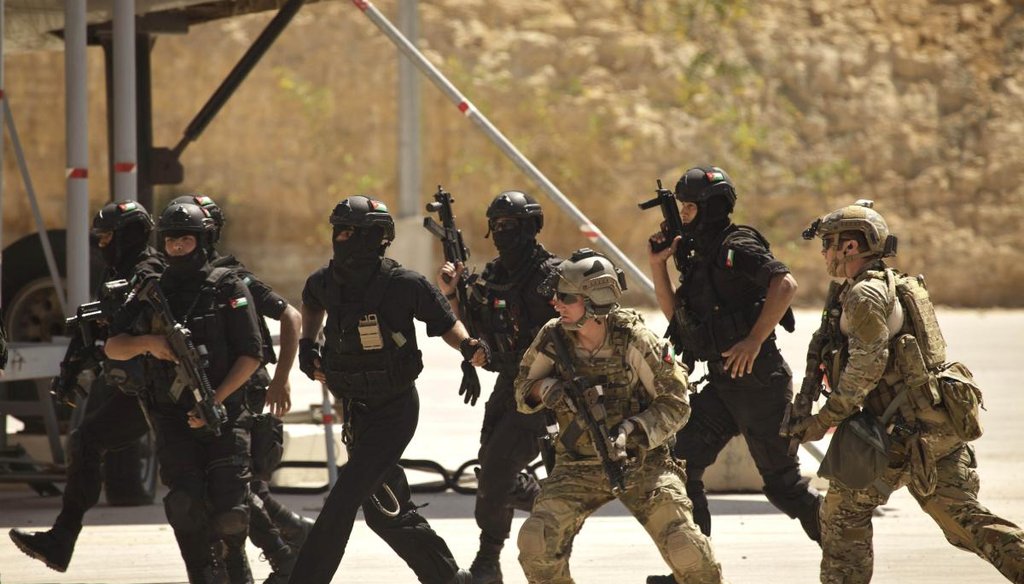Get PolitiFact in your inbox.

Special operations forces from Jordan and the United States conduct a combined demonstration with commandos from Iraq in Amman, Jordan, on June 20, 2013. (AP file photo)
Republican candidates have portrayed the country’s military spending as woefully inadequate under the Obama administration.
They say the cuts, many made as part of the funny-sounding word "sequestration," put the United States at risk in the fight against terrorism But the White House argues that it has been working to increase spending on the military, with some results.
The facts are sometimes murky, which makes it hard to know the truth.
To clear up the confusion, PolitiFact has answers to five common questions about military spending and equipment under the watch of President Barack Obama.
Want to know more? Read all of our fact-checks about the military and terrorism.
Has the military budget dropped under Obama, and if so, who is to blame?
Overall spending on national security includes the Pentagon budget as well as spending by other agencies, such as the Energy Department’s work on nuclear weapons. Spending increased in 2010 and 2011, but it has fallen every year for four years since then by a cumulative 15 percent.
Other ways of looking at the question show declines as well. National security spending made up 20.1 percent of the federal budget in 2010, but in 2015 it was 15.9 percent. Over the same period, spending fell from 4.6 percent of gross domestic product to 3.3 percent.
There are two main reasons for the spending drop. The first is the Obama administration’s decision to start removing U.S. troops from Iraq and Afghanistan. The second has to do with a process known as sequestration.
Sequestration refers to the framework for automatic, across-the-board cuts to both military and non-military spending that were originally designed to force bipartisan negotiators in Congress to strike a deal in 2011. When negotiations fell apart, the cuts went into effect.
The bipartisan nature of the sequestration provision means that both parties merit a share of the blame, experts say.
The most recent Obama budget proposed a 7.8 percent increase in the base Defense Department budget between 2015 and 2016. The spending bill enacted this fall puts the defense budget on a path to start growing in fiscal year 2016, up about 6 percent from the previous year.
"It’s still not quite as much as the president requested, but it’s much closer," said Todd Harrison, director of defense budget analysis at the Center for Strategic and International Studies.
How much is the Army shrinking?
Republican presidential candidate U.S. Sen. Marco Rubio brought up declining military spending while on the campaign trail at the Iowa State Fair, deeming it an example of the government failing on its "most important obligation" of keeping Americans safe.
He said, "We have an Army that just cut 40,000 spots."
This rates Mostly True.
In 2012, the Army had about 570,000 soldiers. Reductions over several years have taken it down to its current size of about 490,000. Rubio was referring to the Army’s announcement in July that it plans to cut the regular Army from 490,000 to 450,000 by fiscal year 2018, or a total of 40,000 positions.
As of early December, 1,299 soldier positions have been cut. The new cuts, which are scheduled to end by October 2018, will save about $7 billion.
Do we have the smallest Navy since 1917?
A popular talking point about the United States having the "smallest Navy" in almost a century emerged in the 2012 presidential campaign and has seen new life this cycle.
"I'm going to rebuild our military," said Sen. Lindsey Graham, R-S.C., on June 4, 2015. "We're on a course to have the smallest army since 1940, the smallest Navy since 1915."
The literal accuracy of the claim has changed recently and from year to year. In 1916, the U.S. Navy had 245 active ships. The number peaked at a massive 6,768 ships during World War II. Then the number drifted down during most of the 20th century, with slight upticks during the Korean War and the Vietnam War.
As of Dec. 9, 2015, the number of active ships stood at 272, which is the lowest since 1916.
However, the ships of 1917 were most definitely not the ships of today. The types of ships active in 1917 that are also active today -- such as cruisers and destroyers -- are now outfitted with far more advanced technology than they were during World War I. And today, the U.S. Navy has 11 aircraft carriers (plus the jets to launch from them), 31 amphibious ships, 14 submarines capable of launching nuclear ballistic missiles and four specialized submarines for launching cruise missiles — all categories of vessels that didn't even exist in 1916.
And all are more effective at projecting seapower than their forebears. The comparison "doesn’t pass ‘the giggle test,’ " William W. Stueck, a historian at the University of Georgia, told us in 2012.
In March 2015, the Navy, after a formal process completed in 2014 to consider its future military needs, set a goal for a fleet of 308 ships. Given the current shipbuilding schedule, that goal would not be met until 2022 at the earliest. And that depends on repealing sequestration.
Is the United States building new military equipment?
Rubio made a less accurate attack when he said the United States "is not building the aircraft, the long-range bombers, the additional aircraft carriers, (or) the nuclear submarines." We rated that claim False.
The United States is, in fact, building various military equipment, though there is debate among experts as to whether it is happening fast enough. Here is an updated summary of some of what we found:
-
The Navy is building 12 ballistic missile submarines to replace the current force of 14 beginning with the first hull in 2021. The Navy budgeted $1.4 billion for research and development in fiscal year 2016, but the challenge is funding the total of about $103 billion.
-
The Defense Department is in the middle of the largest aircraft procurement ever for the F-35 Joint Strike Fighter. In recent years, around 30 have been built a year, and that will ramp up to 100 a year around 2017. Plans call for acquiring 2,443 joint strike fighters over about 20 years at a cost of nearly $400 billion.
-
In October, the Air Force awarded a contract for the new bomber program, known as a long-range strike bomber. However, the bid is currently under protest by Boeing. The cost estimate is $21.4 billion for the engineering and manufacturing development phase and then $550 million per aircraft for the first 21 of 100. The 100 planes are expected to be done by the 2020s.
What’s the status of our nuclear arsenal?
Both Rubio and Donald Trump have portrayed our nuclear weapons as out of date.
While the United States has reduced the number of warheads, the government is in the process of extensive nuclear modernization efforts. The United States has been spending billions to improve nuclear equipment, and there are plans to do more.
"It is an ironic fact that the president who won a Nobel Peace Prize for his soaring disarmament rhetoric is the same president who has laid out $1 trillion plan to modernize every aspect of the U.S. nuclear arsenal over the next 30 years," said Matthew Bunn, an expert on nuclear proliferation and a professor Harvard University.
Rubio also said that the United States was "the only nation" not modernizing its weapons, but it’s misleading to compare the United States on that basis to other countries. The United States and Russia have over 90 percent of the world’s nuclear weapons. China, for example, is modernizing its arsenal, but its arsenal is also far smaller.
Obama has cut the number of nuclear weapons by a smaller percentage than any American president since the end of the Cold War, according to an analysis by Hans Kristensen, director of the Nuclear Information Project at the Federation of American Scientists Obama’s 10 percent reduction over six years trails even George W. Bush’s 50 percent.
Our Sources
Defense News, "USAF Wants to buy 100 long range strike-bombers," Dec. 2, 2015
Defense News, "Air Force ‘confident’ bomber contract award is airtight," Nov. 10, 2015
PolitiFact, "Marco Rubio says the United States is not modernizing its nuclear weapons," May 5, 2015
PolitiFact, "Marco Rubio says the United States isn't building aircraft, bombers, nuclear subs," May 5, 2015
PolitiFact, "Donald Trump says 'our nuclear arsenal doesn't work,'" June 18, 2015
PolitiFact, "Jeb Bush says Democrats 'responsible' for 'swift, mindless' cuts to defense spending," June 22, 2015
PolitiFact, "Anatomy of a talking point: the smallest Navy since 1917," Aug. 3, 2015
Interview, Air Force Maj. Robert Leese, Dec. 4, 2015
Interview, Navy LTJG Kara Yingling, Dec. 4, 2015
Interview, Army LTC Joe Buccino, Dec. 4, 2015
Interview, Joe DellaVedova, Public Affairs Director, F-35 Lightning II Joint Program Office, Dec. 4, 2015
Interview, Matthew Bunn, nuclear specialist at the Harvard Kennedy School, Dec. 4, 2015
Interview, Lance Janda, historian at Cameron University, Dec. 7, 2015
Interview, Steve Ellis, vice president of Taxpayers for Common Sense, Dec. 7, 2015
Interview, Todd Harrison, fellow with the Center for Strategic and Budgetary Assessments, Dec. 7, 2015













































